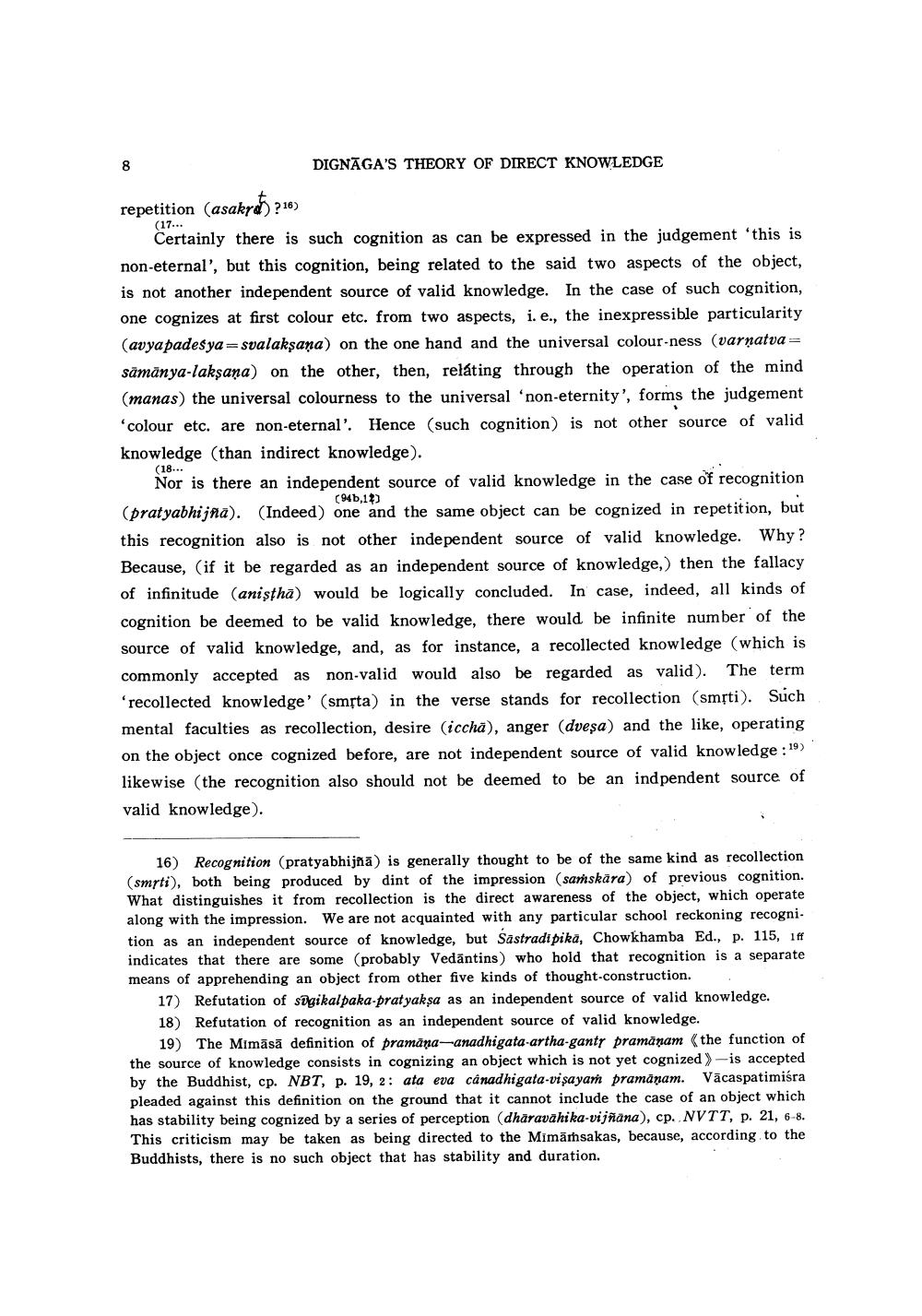Book Title: Dignagas Theory Of Direct Knowledge Author(s): Massaki Hattori Publisher: Massaki Hattori View full book textPage 8
________________ DIGNAGA'S THEORY OF DIRECT KNOWLEDGE (18.. (94b,12) repetition (as (17... Certainly there is such cognition as can be expressed in the judgement 'this is non-eternal', but this cognition, being related to the said two aspects of the object, is not another independent source of valid knowledge. In the case of such cognition, one cognizes at first colour etc. from two aspects, i. e., the inexpressible particularity (avya padesya=svalaksana) on the one hand and the universal colour-ness (varnatva= samanya-laksana) on the other, then, relating through the operation of the mind (manas) the universal colourness to the universal 'non-eternity', forms the judgement 'colour etc. are non-eternal'. Hence (such cognition) is not other source of valid knowledge (than indirect knowledge). Nor is there an independent source of valid knowledge in the case of recognition (pratyabhijna). (Indeed) one and the same object can be cognized in repetition, but this recognition also is not other independent source of valid knowledge. Why? Because, (if it be regarded as an independent source of knowledge,) then the fallacy of infinitude (anistha) would be logically concluded. In case, indeed, all kinds of cognition be deemed to be valid knowledge, there would be infinite number of the source of valid knowledge, and, as for instance, a recollected knowledge (which is commonly accepted as non-valid would also be regarded as valid). The term 'recollected knowledge' (smsta) in the verse stands for recollection (smsti). Such mental faculties as recollection, desire (iccha), anger (dvesa) and the like, operating on the object once cognized before, are not independent source of valid knowledge : 19) likewise (the recognition also should not be deemed to be an indpendent source of valid knowledge). 16) Recognition (pratyabhijna) is generally thought to be of the same kind as recollection (smrti), both being produced by dint of the impression (samskara) of previous cognition. What distinguishes it from recollection is the direct awareness of the object, which operate along with the impression. We are not acquainted with any particular school reckoning recogni. tion as an independent source of knowledge, but Sastradi pika, Chowkhamba Ed., p. 115, 1ff indicates that there are some (probably Vedantins) who hold that recognition is a separate means of apprehending an object from other five kinds of thought-construction. ion of spaikalpaka-prat yaksa as an independent source of valid knowledge. 18) Refutation of recognition as an independent source of valid knowledge. 19) The Mimasa definition of pramana-anadhigata-artha-gant, pramanam (the function of the source of knowledge consists in cognizing an object which is not yet cognized -is accepted by the Buddhist, cp. NBT, p. 19, 2: ata eva canadhigata-visayar pramanam. Vacaspatimisra pleaded against this definition on the ground that it cannot include the case of an object which has stability being cognized by a series of perception (dharavahika-vijnana), cp. NVTT, p. 21, 6-8. This criticism may be taken as being directed to the Mimarsakas, because, according to the Buddhists, there is no such object that has stability and duration.Page Navigation
1 ... 6 7 8 9 10 11 12 13 14 15 16 17 18 19 20
